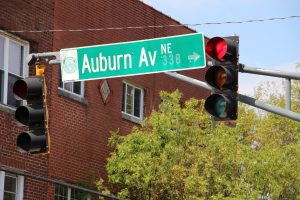
Auburn Av Street Sign Degrading
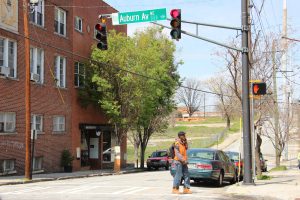
Construction worker crossing the street on Auburn Av
This is an image of a construction worker crossing the street on Auburn Av. The background of the image depicts how underdeveloped and underfunded the surrounding area is. The worker was one of about a dozen people we saw walking by, which indicated that the community was relatively barren. Also, the sign itself saying “Auburn Av” is fading, again indicating the lack of money going to this area.
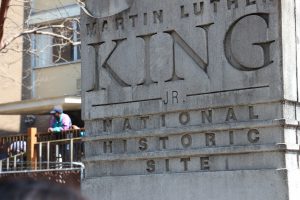
Sign for the MLJK National Historical Site with members of the Sweet Auburn Community in the back
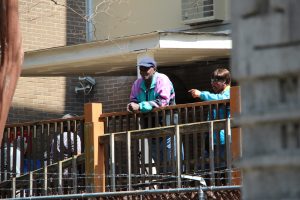
Members of the Sweet Auburn Community Looking Out at the MLKJ Memorial
This is one of the major signs indicating the beginning of the Martin Luther King Jr. National Historic Site, which includes MLKJ’s childhood home and the Ebenezer Baptist Church. In the background of this image, I captured some local Sweet Auburn Community members who embody the the admiration and respect that this community has for MLKJ.
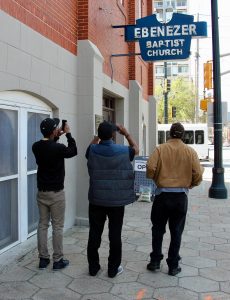
Visitors admiring the Ebenezer Baptist Church, where MLKJ was a Pastor
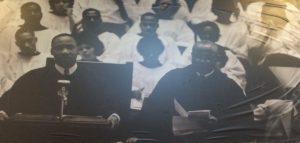
Martin Luther King Jr. giving sermon at Ebenezer Baptist Church
Visitors admiring the Ebenezer Baptist Church, which is a part of the Martin Luther King Jr. National Historic Site. From 1960-1968, Martin Luther King Jr. served as co-pastor with his father, known as “Daddy King.” Through preliminary research, I found an image of MLKJ and his father giving a sermon in the church, which is seen in the image to the right.
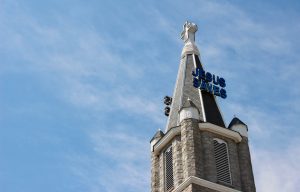
Jesus Saves sign at the Big Bethel AME Church
Religion and Christianity are a very large part of many members lives in the Sweet Auburn community. The “Jesus Saves” is an iconic sign and landmarks for Atlantians driving in the city.
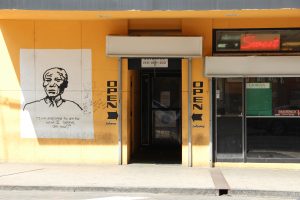
Art and Store on Auburn Av
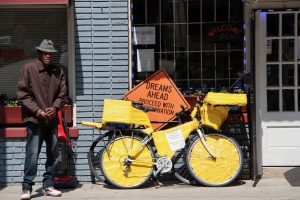
Local Member of the Sweet Auburn Community
Two photographs of the contrast between poverty and history on Auburn Ave. On the left, there is contrast between the inspiring Nelson Mandela quote/mural on a bright yellow wall and an empty local business. On the right depicts the juxtaposition between an optimistic MLKJ reference to “dreams ahead” on a bicycle art structure and a distressed individual who doesn’t appear to seem as happy as the bright yellow structure next to him (of course, he may just look like that because he doesn’t like strangers like me taking a photo of him).
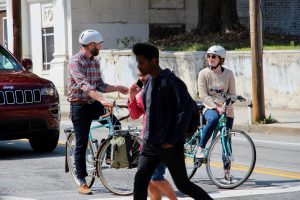
Gentrification of Auburn Av
Here, I captured two young, white, bikers smiling and having a conversation on the street. They were coming from the west, heading into the east side of Auburn Av (where the majority of the historical sites are). To me, these folk represent the gentrification of this area. They are dressed in the typical fashion that represents the community that tends to participate in the gentrification and relocation of the original community of an area. This photo is particularly interesting because when I was taking it (to capture a symbol of gentrification), a young black man walked by in front of them. The exposure in the photo, where the black man is in blur and in less of focus, suggests that the impending gentrification of the Auburn Av community may displace or forget about the black community that is currently living there.
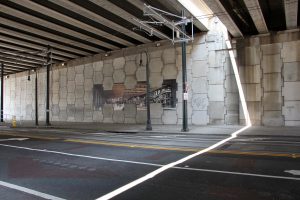
Light shining through a dark tunnel on Auburn Av
Despite the poverty and lack of vivacity we saw walking around the area, there appears to be some “light shining through the dark.” I captured this image because I loved how the light streak from above the tunnel illuminated the dark space. To the left of the light is an artistic image that depicted a booming Auburn avenue. Like the light coming through in this photo, there is hope for the future of the Auburn community.